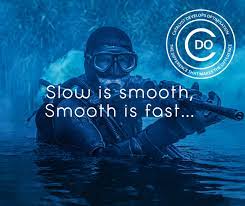In the words of ancient Chinese philosopher Lao Tzu, “Nature does not hurry, yet everything is accomplished.”
Go, go, go.
It’s been the ethos of how Americans approach work and life. I understand; my highest “Driving Force” on the TTI Assessment is “Urgency.” In fact, I statistically place that value higher than 97% of the population.
Yet, there’s a profound maxim that originates from the Special Operations community, “Slow is smooth, and smooth is fast.” Seemingly counterintuitive, this phrase holds a world of wisdom that can drastically enhance productivity and performance across many disciplines.
At its core, the saying “Slow is smooth, and smooth is fast” emphasizes the importance of accuracy, consistency, and a controlled pace in executing tasks. Contrary to popular belief, the fastest route to success isn’t always about rushing headlong into tasks. It’s about maintaining a rhythm, a smoothness in operation that naturally leads to increased speed and efficiency. In Scaling Up, we call this a cadence.
This principle has its roots in military and law enforcement circles, particularly among Special Forces units such as the Navy SEALs. It was initially developed as a training mantra for situations where speed and precision were both critical. However, it has since transcended these boundaries, finding relevance in various domains, including business, sports, and even personal development.
In the world of music, renowned cellist Pablo Casals once said, “I play the notes as they are written, but it is God who makes the music.” The essence of his statement aligns with this philosophy — when musicians focus on playing each note smoothly and accurately, the result is a faster, more harmonious melody.
The Science
Scientific studies support the notion that “slow is smooth, and smooth is fast.” When we rush, our brain’s prefrontal cortex, responsible for executive functions such as decision-making and problem-solving, becomes overloaded. This stress response can lead to errors, diminished creativity, and even burnout.
On the other hand, when we slow down, we allow our brains to fully engage with the task at hand. This focused approach facilitates more robust neural connections, promoting learning and mastery. As proficiency grows, speed naturally follows. In a study conducted by Stanford University, researchers found that students who were taught to understand the concepts deeply, even if it meant learning at a slower pace initially, outperformed their peers in the long run.
In Business
In a business context, rushing to get a product to market can often result in overlooked details and errors. However, by taking the time to thoroughly understand consumer needs, fine-tuning the product, and ensuring a smooth production process, businesses can provide a superior product in less time. Apple slowly develops products rather than rushing new ideas to market, which seems to have worked well for them. This approach also applies to customer service, where resolving customer issues effectively, even if it takes a bit longer initially, leads to improved customer satisfaction and loyalty.
When I was a kid, I helped my father in his construction company. Often I’d take measurements and quickly run to the saw to make the cuts. Hoping my speed would impress my father. Typically the cuts were off; I’d waste both time and resources, having the inverse effect of what my father wanted. He would say, “we like it right, so we cut it twice,” mocking my expediency.
In Personal Development
Mastering a new skill or habit requires patience and consistency. The initial stages might feel slow as we grapple with new concepts and techniques. But as we become more comfortable, our movements become smoother, and we begin to perform the task more quickly and efficiently.
In the diagram above, we see the causal relationship between our approach (slow or fast) and the ensuing results. A slow approach leads to a comprehensive understanding, smooth execution, and fast results. Conversely, a fast approach results in a superficial understanding, rough execution, and inefficient results.
In a society that often equates speed with success, embracing the philosophy of “Slow is smooth, and smooth is fast” may seem counterintuitive. However, it’s clear that slowing down to ensure smooth execution can lead to increased speed and success in the long run.
Whether we’re learning a new instrument, launching a product, or resolving customer complaints, this principle offers a valuable framework for improving performance and productivity. By consciously slowing down, we allow ourselves the space to understand deeply, act smoothly, and, ultimately, move faster.
Let’s take a leaf from nature’s book and remember slow is smooth, and smooth indeed is fast.
Note:
Are you a content creator? If yes then we welcome bloggers & they can submit a guest post to our famous blog for free, just search in google, we are on top of search engine “ write for us + home”, You will find “Lifeyet News”.
 Lifeyet News Lifeyet News
Lifeyet News Lifeyet News





